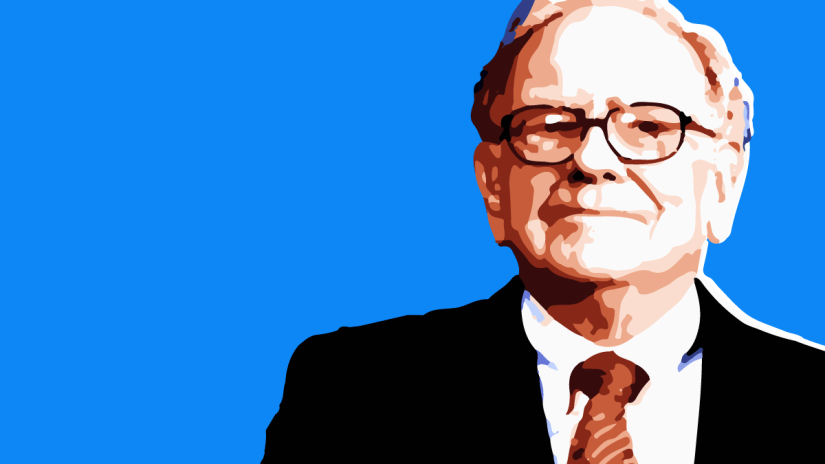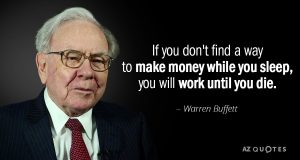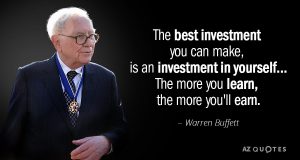
Warren Buffett Personal History and Investment Beginnings
Warren Edward Buffett was born August 30, 1930, in Omaha, Nebraska. He was the seventh generation of Buffett’s to call Omaha home. The first Nebraskan Buffett opened a grocery store in 1969.
Buffett grandfather also ran a grocery store and once employed a young Charlie Munger, the future vice chairman of Berkshire Hathaway. Buffett’s father, Howard, was a local stockbroker and banker who later becomes a Republican Congressman.
It was said that as soon as Warren Buffett was born he was fascinated by numbers. That may be a stretch, but it is well documented that before he entered kindergarten he was already a calculating machine. As young boys, he and his best friend Bob Russell would sit on the Russell family porch recording license-plate numbers of the cars that passed by. When darkness fell, he and Bob would go inside, spread the Omaha World-Herald on the floor, and count the number of times each letter appeared in the paper. They then tallied their calculations in a scrapbook, as if it was top-secret information.
One of the young Buffett’s most prized toys came from his Aunt Alice, who was quite fond of her peculiar but immensely likable nephew and made him an irresistible offer: if he would agree to eat his asparagus, she would give him a stopwatch. Buffet was mesmerized by this precise counting machine and used it in endless little-boy ventures, like marble races. He would summon his two sisters into the bathroom, fill the tub with water, and then direct them to drop their marble into one end. The one whose marble reached the drain stopper first was the winner (utilizing the tub’s sloped shape). Buffett, stopwatch at the ready, timed and recorded each race.
But it was the second gift from Aunt Alice that sent six-year old Buffett into a new direction—a fascination not with just numbers, but with money. On Christmas day, Buffett ripped open his present and strapped onto his belt what would become his most treasured possession—a nickel-coated money changer. He quickly found many ways to put it to good use. He set up a table outside his house and sold Chiclets to anyone who passed by. He went door-to-door selling packs of gum and soda pop. He would by a six-pack of Coke at his grandfather’s grocery store for 25 cents and sell the individuals bottle for a nickel: 20 percent return on investment. He also sold door-to-door, copies of the Saturday Evening Post and Liberty magazine. Each weekend he sold popcorn and peanuts at local football games. With him through all these enterprise was his money changer, taking in dollars and making change.
What now sounds like an idyllic childhood took an abrupt turn when Buffett’s father returned home one night to inform the family the bank where he worked has closed. His job was gone and their savings were lost. The Great Depression has finally made its way to Omaha. Buffett’s grandfather, the grocery store owner, gave Howard money to help support his family.
Fortunately, the sense of hopelessness did not last long. Howard Buffett soon pulled himself up and go back to his feet, announcing that Buffett, Sklenicka & Company had opened for business at the Union State building on Farnam Street, the same street where Buffett would someday buy a house and start his investment partnership.

The effect of the Great Depression, albeit brief, was hard on Buffett’s family. It also made a deep and profound impression on young Warren. “He emerged from those first hard years with Lowenstein, author of Buffett: The Making of an American Capitalist. “He thought about it before he was five years old. And from that time on, he scarcely stopped thinking about it.”
When Buffett turned 10, his father took him to New York, It was a birthday gift Howard gave to each of his children. “I told my Dad I wanted to see three things,” said Buffett. “I wanted to see the Scott Stamp and Coin Company. I wanted to see the Lionel Train Company. I wanted to see the New York Stock Exchange.” After an overnight ride on the train, Buffett and his dad made their way to Wall Street, where they met with At Mol, a member of the exchange. “After Launch, a guy came along with a tray that had all these different kinds of tobacco leaves on it,” recalled Buffett. “He made up a cigar for Mr. Mol, who picked out the leaves he wanted. And I thought, this is it. It doesn’t get any better than this. A custom-made cigar.
Later, Howard Buffett introduced his son to Sidney Weinberg, a senior partner at Goldman Sachs, and then considered the most famous man on Wall Street. Standing in Weinberg’s office, Buffett was mesmerized by the photographs and documents on the wall. He took note of the framed original letters, knowing full well they were written by famous people. While Howard and Sidney talked about financial issues of the day, Buffett was oblivious, walking around and around Weinberg’s office staring at the artifacts. When it was time to go, Sidney Weinberg put his arm around Buffett and jokingly asked him what stock he liked. “He’d forgotten it all the next day,” Buffett recalled, “but I remembered it forever.”
Even before Buffett traveled to New York, he was already intrigued with stocks and the stock market. He was a frequent visitor to his dad’s brokerage office, where he would stare at stock and bond certificates that hung on the wall, just like in Sidney Weinberg’s office. Often he would bounce down the two flights of stairs right into the Harris Upham brokerage firm. Many of the brokers became fond of the pesky kid who never seemed to stop asking questions. From time to time they would allow young Warren to chalk the prices of stocks on the blackboard.
On Saturday mornings, when the stock exchange was open for two hours, Buffett would hang out with his paternal great-uncle Frank Buffett and his material great-uncle John Barber at the brokerage office. According to Buffett, Uncle Frank was a perpetual bear and Uncle John was the ever-optimistic bull. Each competed for Buffett’s attention with stores of how they thought the world would unfold. All the while, Buffett stared straight ahead at the Trans-Lux stock ticker, trying to make sense of the continually changing stock prices. Each weekend he read the “trader” column in Barron’s. He consumed all the investment books at the local library. Soon he began charting the stock prices himself, trying to understand the numerical patterns that were flashing by his eyes.
No one was surprised when 11-year-old Buffett announced he was ready to buy his first shares of stock. However, they were stocked when he informed his family he wanted to invest $120, money he had saved from selling soda pop, peanuts, and magazines. He decided on Cities Service Preferred, one of his father’s favorite stocks, and enticed his sister Doris to join him. They each bought three shares, for an investment of $114.75 each. Buffett had studied the price chart; he was confident. That summer the stock market declined, hitting its yearly low in June. The two junior Buffett’s saw their stocks decline 30 percent. Not a day went by when Doris did not pester Warren about their loss, so when Cities Service Preferred recovered to $40 per share, he sold their holdings, for a $5 profit.

To Buffett’s chagrin, Cities Service Preferred soon soared to $202 a share. After commission, Buffett calculated he had forgone a profit of over $492. Since it had taken him five years to save $120, he figured he had just given up 20 years of work. It was a painful lesson, but ultimately a valuable one. Buffett swore that, first, he would never again be sidetracked by what he paid for the stock, and, second, he would not settle for small profits. At the wise age of 11, Buffett has already learned one of the most important lessons in investing—patience.
In 1942, when Buffett was 12, his father was elected to the U.S Congress and moved the family to Washington. The change was hard on the young boy. Miserable and hopelessly homesick, he was allowed to return to Omaha for a year, to live with his grandfather and Aunt Alice. The following year, 1943, Warren gave Washington another chance.
With no friendly brokerage firms to hang out in, gradually Buffett’s interest moved away from the stock market and toward entrepreneurial ventures. At age 13, he was working two paper routes, delivering the Washington Post and the Washington Times-Herald. At Woodrow Wilson High School, he made friends with Don Danly, who quickly become infected with Buffett’s enthusiasm for making money. The two pooled their savings and bought reconditioned pinball machine for $25. Buffett convinced a local barber to let them put a machine in his shop for half the profits. After the first day of operation, the returned to find $4 in nickels in their very first machine. The Wilson Coin-Operated Machine Company expanded to seven machines, and soon Buffett was taking home $50 per week.
By the time Buffett graduated from high school, his savings from various endeavors totaled $9,000. He promptly announced that he saw no reason to go to college, as it would interfere with his business ventures. His father overruled him, and by the fall Buffett found himself enrolled at the University of Pennsylvania’s Wharton School of Business and Finance. Despite Wharton’s emphasis on business and finance, Buffett was unimpressed with the university. “Not exactly turned on by it,” he confessed; “it didn’t seem like I was learning a lot.” The Wharton curriculum stressed the theoretical aspects of business; what interested Buffett were the practical aspects of a business—how to make money. After two years at Wharton (1947-1949), he transferred to the University of Nebraska. He took 14 courses in one year and graduated in 1950. He was not yet 20 years old.
Back in Omaha, Buffett reconnected with the stock market. He started collecting hot times from brokers and subscribed to publishing his services. He resurrected his price charts and studied books on technical analysis. He applied the McGee point-and-figure system and every other system he could think of, ty9ing to figure out what would work. Then one day, browsing in the local library, he came across a recently published book title The Intelligent Investor by Benjamin Graham. “That,” he said, “was like seeing the light.”
Graham’s treatises on investing, including Security Analysis (1934), cowritten with David Dodd, so influenced Buffett that he left Omaha and traveled to New York to study with Graham at the Columbia University Graduate School of Business. Graham preached the importance of understanding a company’s intrinsic value. He believed investor who accurately calculated this value and bought shares below it in price could be profitable in the market. This mathematical approach appealed to Buffett’s love of numbers.
In Graham’s class were 20 students. Many were older than Buffett and several were working on Wall Street. In the evening, these Wall Street professionals sat in Graham’s class discussing which stocks were massively undervalued, and the next day they would be back at work buying the stocks analyzed the night before and making money.
It was soon clear to everyone that Buffett was the brightest student. He often raised his hand to answer Graham’s question before Graham had finished asking it. Bill Ruane, who later cofounded the Sequoia Fund and Rick Cuniff, was in the same class. He recalls that there was in instantaneous chemistry between Graham and Buffett, and the rest of the class was primarily an audience. Buffett’s grade for the class was an A+—the first A+ Graham had awarded in 22 years of teaching.
After graduating from Columbia, Buffett asked Graham for a job but was turned down. At first he was stung by the rejection but later was told that the firm preferred to fill the slots at Graham Newman with Jewish analyst who, it was perceived, were being treated unfairly on Wall Street. Undeterred, Buffett returned to Omaha, where he joined Buffett-Falk Company, his father’s brokerage. He hit the ground running, eagerly recommending stocks that met Graham called with news: The religious barrier had been lifted and there was a seat at Graham-Newman if he was still interested. Buffett was on the next plane to New York.
During his tenure at Graham-Newman, Buffett became fully immersed in his mentor’s investment approach. In addition to Buffett, Graham also hired Walter Schloss, Tom Knapp, and Bill Ruane. Schloss went on to manage money at WJS Ltd. Partners for 28 years. Knapp, Princeton chemistry major, was a founding partner in Tweedy, Browne Partners. Ruane cofounded the Sequoia Fund.
For Buffett, Graham was much more than a tutor. “It was Graham who provided the fist reliable map to that wondrous and often forbidding city, the stock market,” wrote Roger Lowenstein. “He laid out a methodological basis for picking stocks, previously a pseudoscience similar to gambling.” Since the days when 11-year-old Buffett first purchased Cities Service Preferred, he had spent half of his life studying the mysteries of The Snowball: Warren Buffett and the Business of Life, wrote, “Warren’s reaction was that of a man emerging from the cave in which he had been living all his life, blinking in the sunlight as he perceived reality for the first time.” According to Schroeder, Buffett’s original “concept of a stock was derived from the patterns formed by the prices at which pieces of paper were traded. Now he saw that those pieces of paper were simply symbols of an underlying truth.”

In 1956, two years after Buffett arrived, Graham-Newman disbanded and Graham, then 61, decided to retire. Once again Buffett returned to Omaha. Armed with the knowledge he has acquired from Graham, and with the financial backing of family and friends, he began a limited investment partnership. He was 25 years old.
Credits: Robert G. Hagstrom (The Warren Buffett Way)




3 Comments